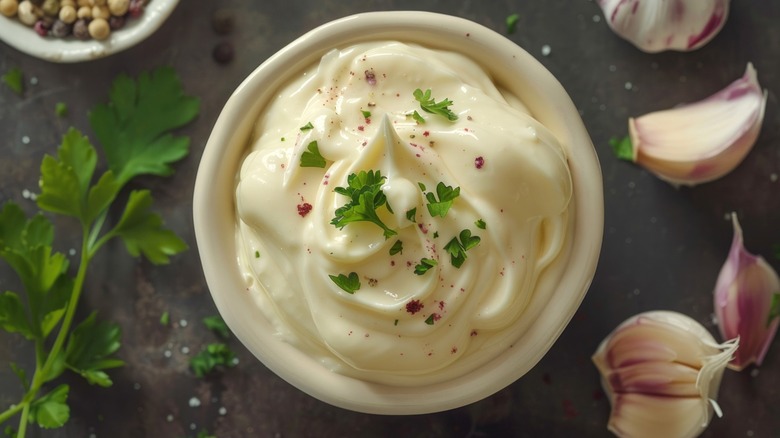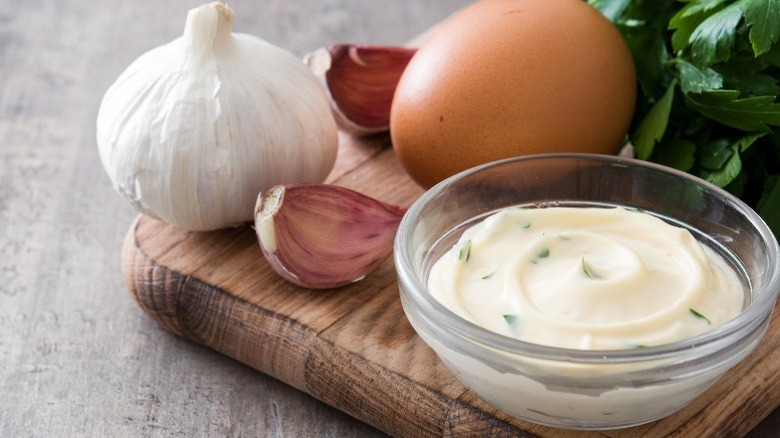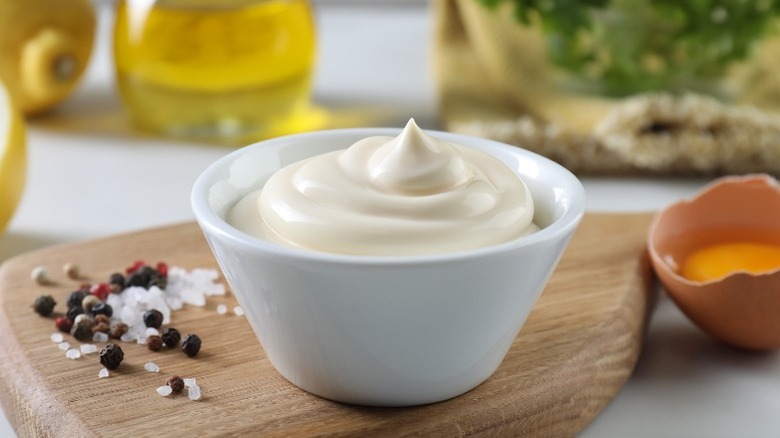What Separates Mayo From Aioli?
It's not unusual to scour a restaurant menu and come across a dish advertising an aioli. It's become a popular way to dress up burgers and sandwiches, but you may notice that sometimes, once the coveted aioli hits the table, it really just looks or tastes like mayonnaise. However, they're not the same. A textbook aioli requires garlic, and mayonnaise requires egg in its recipe.
People might use these terms interchangeably, as aioli and mayo can be similar in appearance. They're both emulsions, which is a term used in cooking to refer to mixing two ingredients that don't want to mix — oil and vinegar, for example. Emulsions can be permanent, like mayo, or temporary, like an oil and vinegar salad dressing that will separate. Aioli and mayo are both permanent emulsions because they have stabilizing ingredients. Egg helps bind the oil and vinegar in mayo, while garlic binds with olive oil and sometimes lemon to create an aioli. Mayo is inherently non-vegan, while a traditional aioli might only consist of oil and garlic.
Aioli is made of garlic and oil (and sometimes an egg)
Aioli is a French word meaning "garlic and oil." A standard homemade aioli is, at minimum, only garlic and oil, but most modern recipes will include egg yolks and lemon juice as well. In the Provence region of France, egg yolk is standard. In other Mediterranean countries like Spain, eggs are less common in the recipe. If you can't eat raw egg yolk, feel free to ask any restaurant how they make their aioli. Eggs serve to add creaminess and mute the garlic's intensity, but it's still possible to enjoy the vegan version.
Aioli is made by crushing the garlic into a paste and stirring in the olive oil using a mortar and pestle. Salt and lemon help bring the emulsion to life and make it the perfect dipping sauce for your French fries. It's not going to have the vinegary taste of mayo, as aioli doesn't require an acid. This thick, garlic-based emulsion is a popular choice for many restaurants because it has a stronger taste than plain mayo.
Mayonnaise is made of eggs and oil (and sometimes an acid)
Mayo is also from French cuisine, but it's a better spread than dipping sauce, making it the perfect addition to sandwiches. Like aioli, no heat is required to make mayo, as it's meant to be served cold. It's made by whisking oil into egg yolks and an acid like lemon or vinegar. Rather than getting its flavor from garlic, mayo's flavor comes from the acidic ingredients. They help break up the eggy taste and give food a lovely zest by working as a condiment.
Mayo seems to have more immediate cooking applications as a hidden ingredient. It's used in mac and cheese, macaroni salad, coleslaw, casseroles, and even as a binding agent in fried chicken. The best mayo is going to be thick, tangy, and homemade. Restaurant mayo just tastes better than the store-bought kind because it's made in-house, but alas, it has a much shorter shelf life. Unless we're talking about Kewpie mayo, which is a chef favorite. Aioli and mayo are both wonderful sauces for dipping, cooking with, or spreading. Restaurants will have their own recipes for each, so it's up to the consumer to figure out which places make it the best. Remember: Mayonnaise always has eggs and oil, while aioli always has garlic and oil — everything else is up to interpretation.


